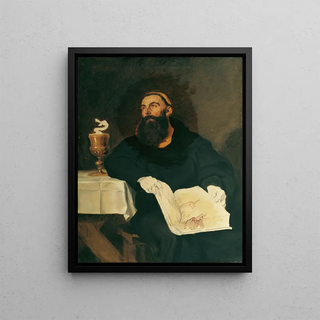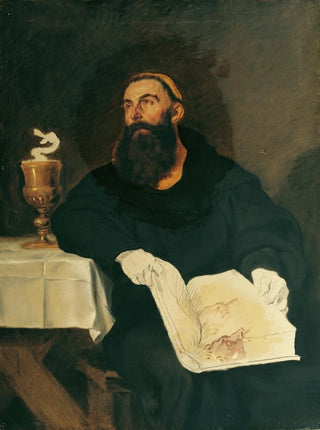Art print | Saint Benoît de Nursie - Hans Canon


View from behind

Frame (optional)
Saint Benedict of Nursia - Hans Canon – Captivating introduction
The art print "Saint Benedict of Nursia" by Hans Canon stands out as an emblematic work, revealing the spiritual depth and artistic richness of the Renaissance. This piece, depicting the founder of the Benedictine order, transcends a simple religious portrait to become a true manifesto of faith and the culture of its time. Immersed in this universe, the viewer is invited to discover not only the figure of Benedict but also the values that shaped Christian Europe. The composition, imbued with serenity, evokes an atmosphere of devotion and wisdom, where every detail is carefully designed to convey a powerful message.
Style and uniqueness of the artwork
Hans Canon's style is characterized by meticulous attention to detail and a subtly harmonized color palette. In "Saint Benedict of Nursia," the artist manages to capture the very essence of his subject through delicate facial expressions and controlled gestures. The saint, dressed in his monastic robe, is depicted in a posture that is both humble and majestic, embodying wisdom and religious fervor. The surrounding elements, such as books and symbols of faith, enrich the visual storytelling, inviting deep contemplation. The light illuminating the saint's face accentuates his spiritual aura, while delicate shadows add a sense of depth and realism to the work.
The artist and his influence
Hans Canon, active in the 16th century, was an artist whose work was influenced by the great masters of the Renaissance, while developing a personal style unique to him. Originating from Flanders, he mastered the techniques of Flemish painting while appropriating the religious themes of his era. Canon is recognized for his ability to combine realism with a spiritual dimension, enabling him to create works that still resonate today. His influence extends beyond his own production, inspiring many contemporary artists who seek to blend technique and emotion in their creations. The depiction of Saint Benedict of Nursia is a perfect example of his talent, illustrating how he manages to transcend the

Matte finish

View from behind

Frame (optional)
Saint Benedict of Nursia - Hans Canon – Captivating introduction
The art print "Saint Benedict of Nursia" by Hans Canon stands out as an emblematic work, revealing the spiritual depth and artistic richness of the Renaissance. This piece, depicting the founder of the Benedictine order, transcends a simple religious portrait to become a true manifesto of faith and the culture of its time. Immersed in this universe, the viewer is invited to discover not only the figure of Benedict but also the values that shaped Christian Europe. The composition, imbued with serenity, evokes an atmosphere of devotion and wisdom, where every detail is carefully designed to convey a powerful message.
Style and uniqueness of the artwork
Hans Canon's style is characterized by meticulous attention to detail and a subtly harmonized color palette. In "Saint Benedict of Nursia," the artist manages to capture the very essence of his subject through delicate facial expressions and controlled gestures. The saint, dressed in his monastic robe, is depicted in a posture that is both humble and majestic, embodying wisdom and religious fervor. The surrounding elements, such as books and symbols of faith, enrich the visual storytelling, inviting deep contemplation. The light illuminating the saint's face accentuates his spiritual aura, while delicate shadows add a sense of depth and realism to the work.
The artist and his influence
Hans Canon, active in the 16th century, was an artist whose work was influenced by the great masters of the Renaissance, while developing a personal style unique to him. Originating from Flanders, he mastered the techniques of Flemish painting while appropriating the religious themes of his era. Canon is recognized for his ability to combine realism with a spiritual dimension, enabling him to create works that still resonate today. His influence extends beyond his own production, inspiring many contemporary artists who seek to blend technique and emotion in their creations. The depiction of Saint Benedict of Nursia is a perfect example of his talent, illustrating how he manages to transcend the






